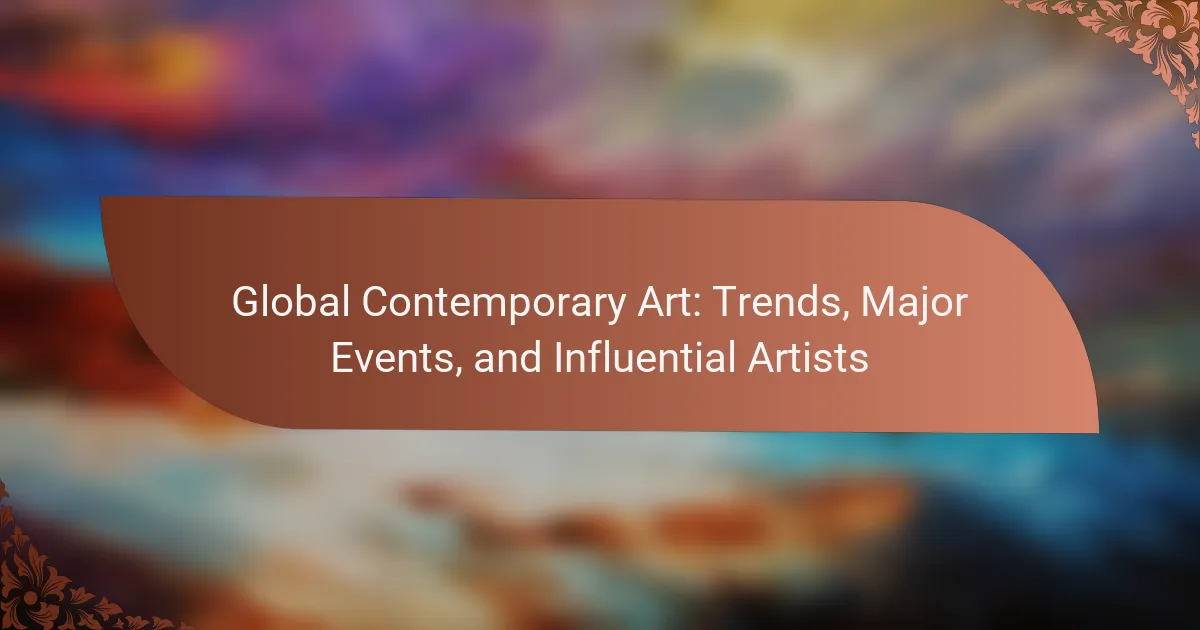Global contemporary art reflects diverse perspectives and engages with pressing social issues. This article explores current trends influenced by digital innovation and environmental concerns. Major events like the Venice Biennale and Art Basel showcase emerging artists and their unique contributions. Influential figures such as Yayoi Kusama and Banksy challenge traditional boundaries, shaping cultural conversations in the art world.
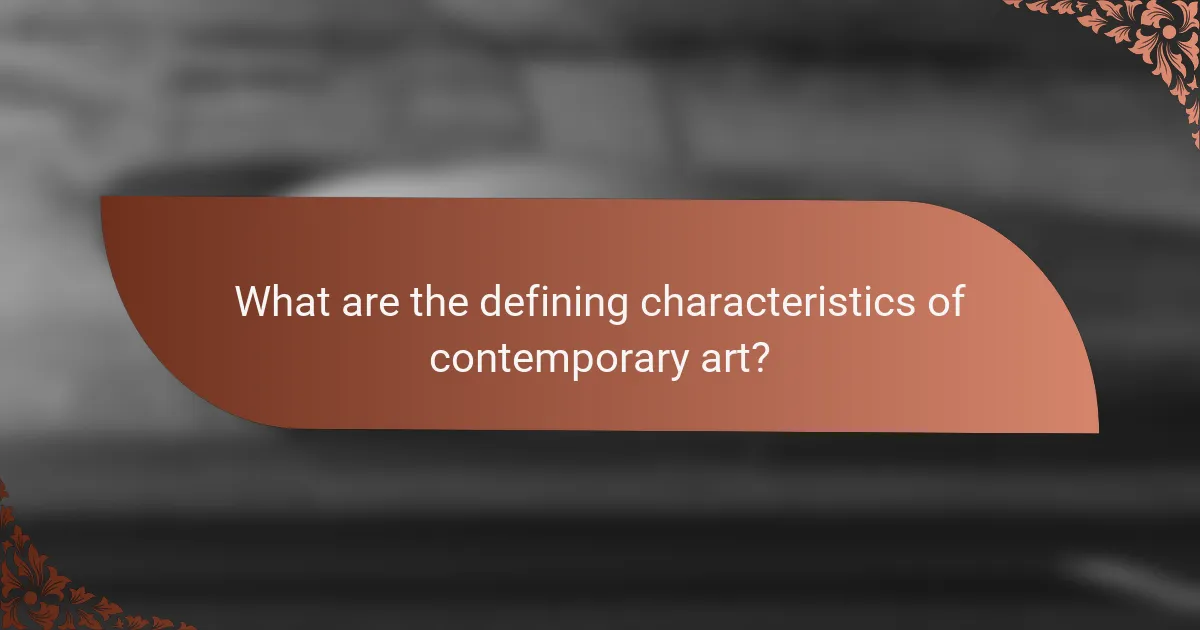
What are the defining characteristics of contemporary art?
Contemporary art is characterized by its diversity, experimentation, and engagement with social issues. It reflects global perspectives and often challenges traditional boundaries. Influential artists and major events shape current trends, emphasizing collaboration and technology. Key characteristics include the use of mixed media, interactive installations, and a focus on identity and culture.
How does contemporary art differ from traditional art forms?
Contemporary art diverges from traditional art forms through its emphasis on concept over technique and its engagement with current societal issues. Contemporary art often incorporates mixed media, installation, and performance, reflecting diverse cultural perspectives. Traditional art typically adheres to established techniques and historical themes, focusing on representational forms. Influential artists in contemporary art challenge norms, pushing boundaries and redefining artistic expression. Major events, such as the Venice Biennale, showcase these trends, highlighting the global dialogue within the contemporary art scene.
What role does technology play in contemporary art creation?
Technology significantly enhances contemporary art creation by providing innovative tools and platforms. Digital media, virtual reality, and artificial intelligence empower artists to explore new dimensions and engage audiences interactively. For instance, AI-generated art challenges traditional notions of authorship and creativity. Moreover, online galleries and social media facilitate global exposure for artists, democratizing access to art and fostering diverse artistic expressions. As a result, technology not only transforms artistic processes but also reshapes the art market and audience engagement.
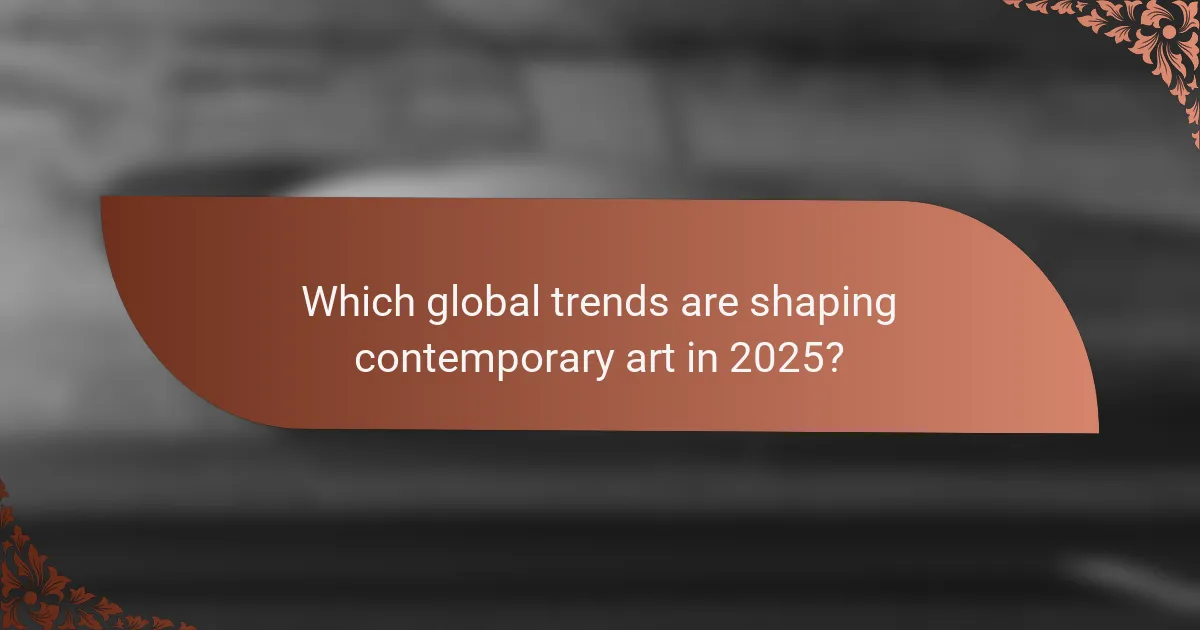
Which global trends are shaping contemporary art in 2025?
Global contemporary art in 2025 is shaped by digital innovation, social activism, and environmental concerns. Artists increasingly embrace technology, utilizing virtual reality and NFTs to redefine art consumption. Major events, such as the Venice Biennale and Art Basel, showcase these trends, attracting global attention. Influential artists like Yayoi Kusama and Banksy lead discussions on cultural relevance and sustainability, pushing boundaries of traditional art forms.
What impact do social movements have on contemporary art?
Social movements significantly influence contemporary art by shaping themes, aesthetics, and public discourse. Artists often reflect societal issues, using their work to advocate for change. For example, movements like Black Lives Matter and Me Too have inspired artworks that address racial injustice and gender equality. These movements provide a platform for artists to engage with pressing social issues, pushing the boundaries of traditional art forms. Moreover, contemporary art increasingly serves as a medium for activism, fostering community engagement and dialogue around critical topics. This intersection of art and social movements highlights the role of artists as catalysts for cultural and political transformation.
How are environmental issues influencing contemporary artistic practices?
Environmental issues significantly influence contemporary artistic practices by prompting artists to explore themes of sustainability and ecological awareness. Artists increasingly address climate change, pollution, and biodiversity loss through various mediums. For example, large-scale installations often utilize recycled materials to raise awareness about waste.
Moreover, many artists collaborate with scientists to create works that reflect environmental data, enhancing public understanding of these pressing issues. This trend aligns with a broader cultural movement towards environmental activism, making art a powerful tool for social change.
As a result, exhibitions focusing on environmental themes attract significant attention, showcasing the intersection of art and activism. These events highlight the role of artists as advocates for the planet, fostering dialogue around urgent global challenges.
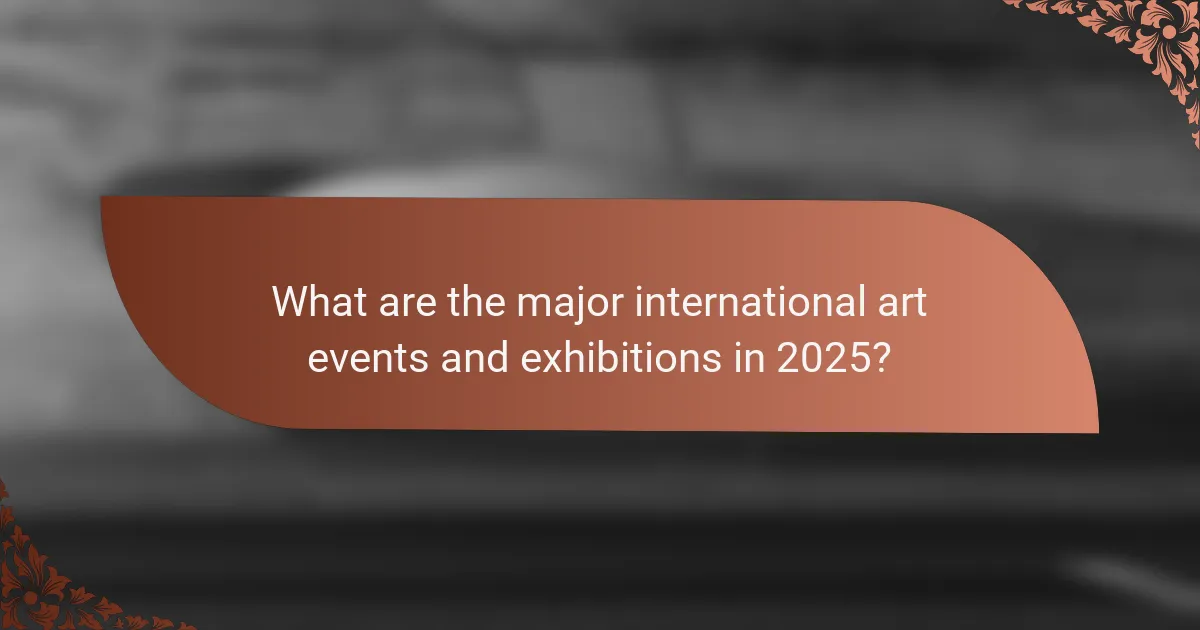
What are the major international art events and exhibitions in 2025?
Major international art events and exhibitions in 2025 include the Venice Biennale, Art Basel, and Frieze Art Fair. These platforms showcase emerging trends and influential artists, shaping the global contemporary art landscape.
The Venice Biennale, a prestigious event, occurs every two years, featuring national pavilions and curated exhibitions. Art Basel, held in multiple cities, highlights contemporary artworks from leading galleries worldwide. Frieze Art Fair, known for its innovative approach, emphasizes contemporary art and includes talks and special projects.
In 2025, these events will likely reflect themes such as sustainability and digital art, showcasing artists who challenge traditional boundaries.
How do art fairs like Art Basel influence the global art market?
Art fairs like Art Basel significantly influence the global art market by setting trends and establishing value benchmarks. These events attract collectors, galleries, and artists, creating a vibrant marketplace. They foster networking, leading to collaborations and increased visibility for emerging artists. Art Basel, specifically, showcases contemporary works that often drive auction prices and shape market demand. The fair’s international reach enables diverse cultural exchanges, further impacting global art trends.
What significance do biennales hold in showcasing contemporary art?
Biennales are significant for showcasing contemporary art as they provide a global platform for artists and foster cultural exchange. They highlight emerging trends and influential artists, shaping the discourse around modern art. Major biennales, like the Venice Biennale, attract international attention and diverse audiences, enhancing visibility for contemporary artworks. These events often feature innovative installations and performances, pushing the boundaries of artistic expression. Additionally, biennales serve as a barometer for the art market, influencing collectors and curators worldwide.
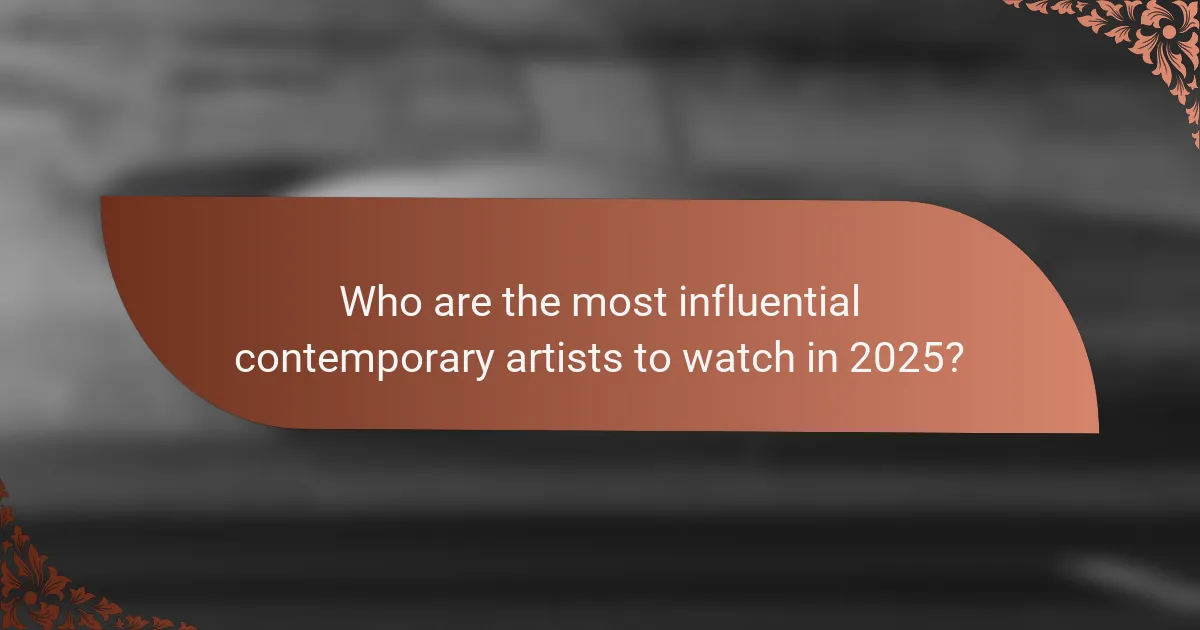
Who are the most influential contemporary artists to watch in 2025?
In 2025, influential contemporary artists include Yayoi Kusama, Ai Weiwei, and Banksy. These artists shape global trends and engage audiences through innovative practices.
Yayoi Kusama is renowned for her immersive installations and polka dot motifs, reflecting themes of infinity and mental health. Ai Weiwei’s activism and multimedia works challenge political boundaries, making him a pivotal voice in contemporary art. Banksy’s provocative street art critiques societal issues, resonating with a wide audience and sparking dialogue.
Emerging talents like Jordan Casteel and Tschabalala Self are also gaining recognition. Their unique perspectives on identity and culture contribute to the evolving landscape of contemporary art.
As the art world continues to evolve, these artists will likely remain at the forefront, influencing future generations and shaping cultural conversations.
What unique perspectives do emerging artists bring to the art scene?
Emerging artists bring fresh perspectives to the art scene through innovative techniques and diverse cultural backgrounds. They often challenge traditional norms and explore contemporary issues, creating work that resonates with a global audience. Their unique attributes include a focus on social commentary and the use of non-traditional materials. This approach fosters inclusivity and encourages dialogue around underrepresented themes. As a result, their contributions enrich the overall narrative of global contemporary art.
How do established artists adapt to contemporary themes?
Established artists adapt to contemporary themes by integrating current societal issues into their work. They often explore themes like identity, climate change, and technology, reflecting their relevance in today’s world.
Many artists utilize mixed media to engage audiences. For instance, they may combine traditional painting with digital elements or installation art. This fusion allows for a dynamic expression that resonates with contemporary viewers.
Collaboration is another strategy. Artists often partner with communities or other creatives to deepen their connection to modern themes. This engagement fosters a dialogue that enriches their artistic narrative.
Finally, established artists frequently participate in global exhibitions and events. These platforms not only showcase their work but also expose them to diverse perspectives, further influencing their adaptation to contemporary themes.
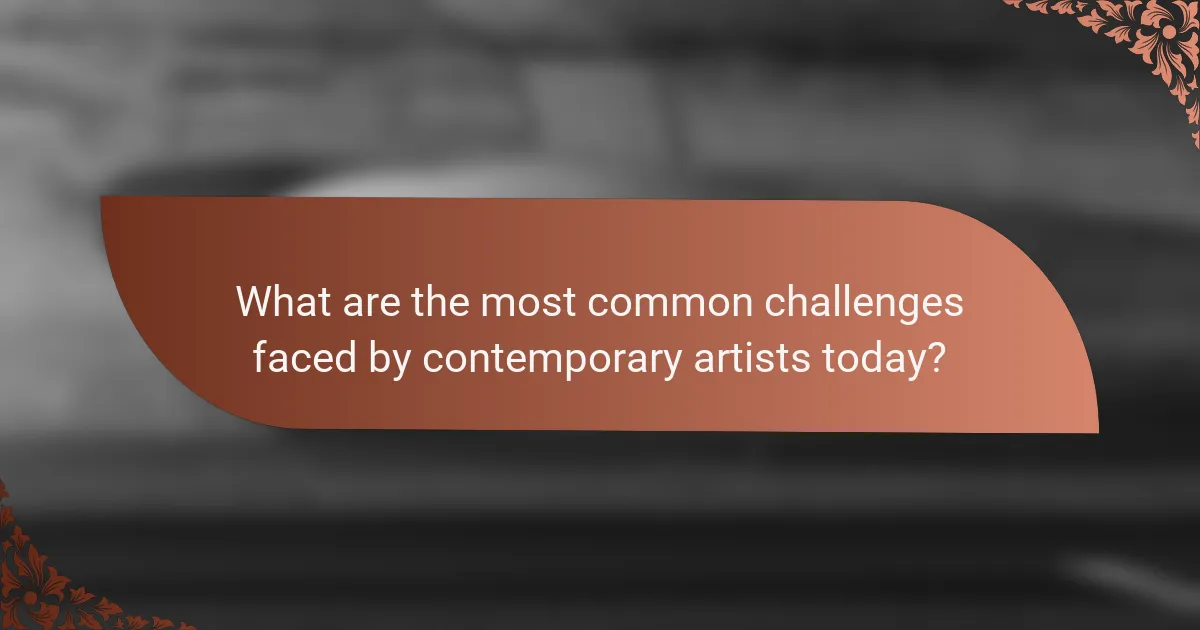
What are the most common challenges faced by contemporary artists today?
Contemporary artists face challenges such as financial instability, market saturation, and limited access to resources. The art world’s rapid evolution complicates visibility and recognition. Additionally, navigating digital platforms and maintaining artistic integrity amidst commercial pressures are significant hurdles. These factors collectively impact artists’ ability to thrive and innovate in the global contemporary art scene.
How does funding impact the work of contemporary artists?
Funding significantly enhances the work of contemporary artists by providing resources for materials, studio space, and exhibition opportunities. Financial support allows artists to experiment and innovate, leading to diverse artistic expressions. Grants and sponsorships often enable participation in major events, expanding visibility and audience reach. Additionally, funding can facilitate collaborations with other artists and institutions, fostering a vibrant art community.
What role does audience engagement play in contemporary art?
Audience engagement is crucial in contemporary art as it fosters interaction and dialogue between artists and viewers. This relationship enhances the experience of art, making it more accessible and relevant. Engaged audiences contribute to the discourse surrounding art, influencing trends and shaping the direction of artistic practices. Events like art fairs and exhibitions often prioritize audience participation, creating immersive experiences that invite feedback and collaboration. As a result, the role of audience engagement is not only about appreciation but also about co-creating meaning within the art community.
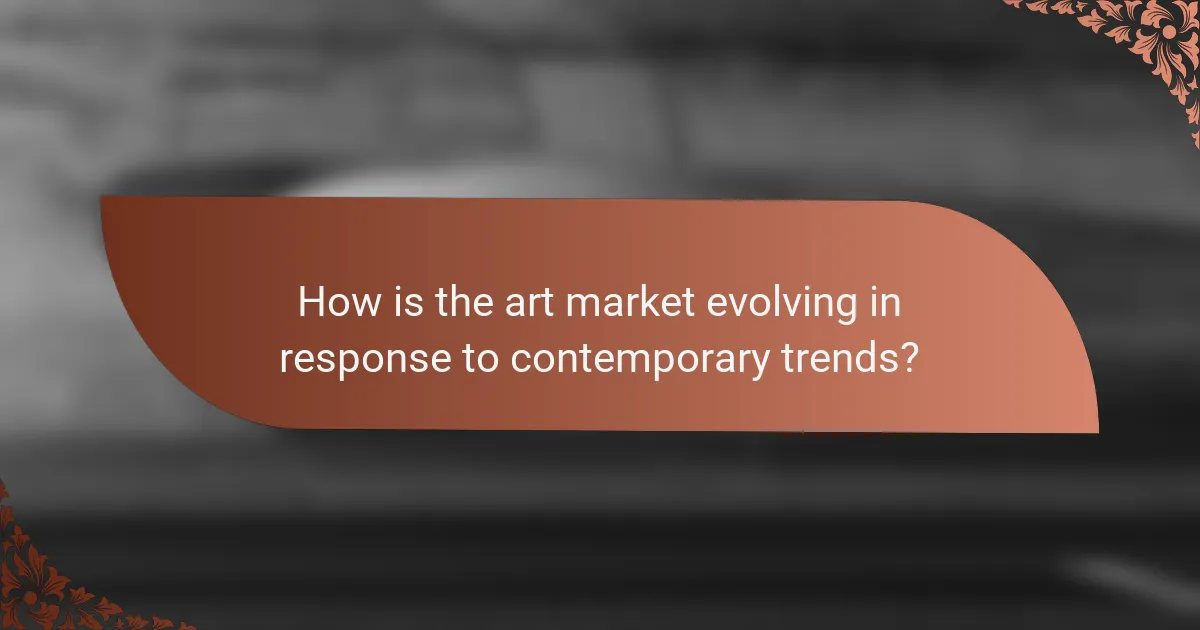
How is the art market evolving in response to contemporary trends?
The art market is evolving through increased digital engagement and a focus on social issues. Contemporary artists are leveraging technology, such as NFTs, to reach broader audiences. Major events like Art Basel now incorporate virtual platforms, enhancing accessibility. Influential artists emphasize themes of identity and climate change, reflecting societal shifts. This evolution signifies a more inclusive and diverse art landscape.
What are the implications of digital art sales and NFTs?
Digital art sales and NFTs have transformed the global contemporary art market by creating new revenue streams and expanding access. Artists can reach global audiences without traditional galleries, enhancing their visibility. NFTs offer unique ownership and provenance for digital works, attracting collectors and investors. This shift challenges existing art valuation methods and raises questions about the future of artistic authenticity and copyright. As a result, the implications for artists and collectors include both opportunities for innovation and risks of market volatility.
How do galleries adapt to the changing landscape of art consumption?
Galleries adapt to the changing landscape of art consumption by embracing digital platforms and experiential engagement. They leverage online exhibitions and social media to reach broader audiences. Additionally, collaborations with technology companies enhance viewer interaction through virtual reality and augmented reality experiences. This shift responds to the increasing demand for accessibility and personalization in art consumption. The rise of direct-to-artist sales models further influences gallery strategies, allowing artists to connect with collectors without traditional intermediaries.
What best practices should artists follow to thrive in the contemporary art market?
Artists should focus on building a strong personal brand, engaging with audiences, and adapting to market trends to thrive in the contemporary art market. Networking is crucial; attending major events enhances visibility. Embracing digital platforms expands reach and allows for innovative presentations. Understanding market dynamics, including pricing strategies and art valuation, is essential. Additionally, continuous learning about artistic techniques and the evolving landscape fosters resilience and relevance.
